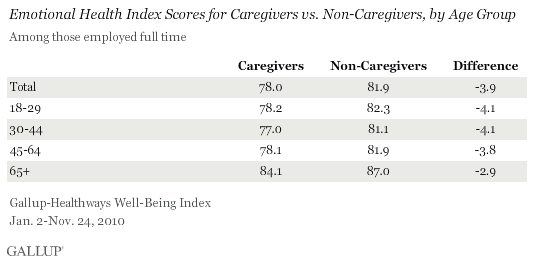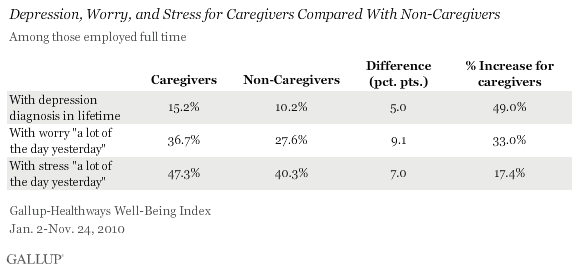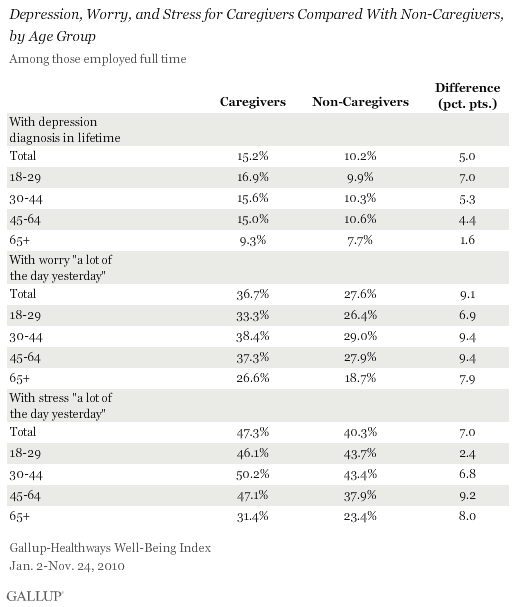This is the third article in a special multipart series on caregiving in America. The explored the relationship between caregiving and overall well-being. The examined caregiving and physical health outcomes.
WASHINGTON, D.C. -- Americans who work a full-time job and say they care for an elderly or disabled family member, relative, or friend, suffer from poorer emotional health than those who work a full-time job but do not have additional caregiving responsibilities. Caregivers, who represent 16% of the full-time American workforce, have an Emotional Health Index score of 78.0, which is significantly lower than the 81.9 found among non-caregivers.

Working caregivers who are younger than 45 exhibit the greatest emotional health deficit relative to non-caregivers, as with and in particular. Although emotional health is typically highest among seniors, caregivers in this age group also have lower emotional health than non-caregivers.
These findings are based on 140,853 interviews with American adults employed full time conducted Jan. 2-Nov. 24, 2010, as part of the . Of these respondents, 23,520 self-identified as caregivers based on their response to the question "Do you currently help care for an elderly or disabled family member, relative, or friend, or not?"
Six percent of caregivers who are employed full time are aged 18 to 29, 22% are aged 30 to 44, 65% are between the ages of 45 and 64, and 6% are aged 65 and older.
The Gallup-Healthways Emotional Health Index comprises 10 items measuring daily emotional experiences and clinical diagnoses of depression.
Caregivers Have More Daily Stress, Higher Rates of Depression
Caregivers are substantially more likely to experience an array of negative emotional health outcomes than their non-caregiving counterparts. Caregivers are 49% more likely than non-caregivers to have ever been clinically diagnosed with depression. They are also more likely to report experiencing worry and stress.

These results hold across all age groups. See page 2 for full results.
Implications
Adult caregivers of all ages are much more likely to report negative emotional health than are those who don't have the same responsibilities. This underscores the need for many caregivers to seek additional support or respite from their routine activities for the sake of their long-term emotional health and, potentially, the well-being of the person for whom they are providing care. For leaders of businesses and organizations, the need to be extra vigilant in the pursuit of sustainable well-being environments for these at-risk associates is reasonable, particularly for those younger than 45.
About the Gallup-Healthways Well-Being Index
The Gallup-Healthways Well-Being Index tracks U.S. and U.K. well-being and provides best-in-class solutions for a healthier world. To learn more, please visit .
Survey Methods
Results are based on telephone interviews conducted as part of the Gallup-Healthways Well-Being Index survey Jan. 2-Nov. 24, 2010, with a random sample of 140,853 adults, aged 18 and older, living in all 50 U.S. states and the District of Columbia, selected using random-digit-dial sampling. Of this sample of respondents, one-sixth self-identified as caregivers. Nearly two-thirds of all caregivers are between the ages of 45 and 64.
For results based on the total sample of national adults, one can say with 95% confidence that the maximum margin of sampling error is 卤0.6 percentage point. For smaller groups, such as caregivers aged 18 to 29 and 65 years old and older, the maximum margin of sampling error is 卤3 percentage points.

Interviews are conducted with respondents on landline telephones and cellular phones, with interviews conducted in Spanish for respondents who are primarily Spanish-speaking. Each daily sample includes a minimum quota of 200 cell phone respondents and 800 landline respondents, with additional minimum quotas among landline respondents for gender within region. Landline respondents are chosen at random within each household on the basis of which member had the most recent birthday.
Samples are weighted by gender, age, race, Hispanic ethnicity, education, region, adults in the household, cell phone-only status, cell phone-mostly status, and phone lines. Demographic weighting targets are based on the March 2010 Current Population Survey figures for the aged 18 and older non-institutionalized population living in U.S. telephone households. All reported margins of sampling error include the computed design effects for weighting and sample design.
In addition to sampling error, question wording and practical difficulties in conducting surveys can introduce error or bias into the findings of public opinion polls.
For more details on Gallup's polling methodology, visit .

